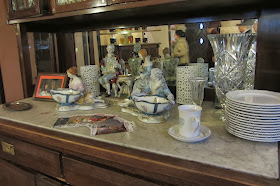 |
| First we walked through the Old City at sunset. |
 |
| The inviting restaurant doorway was a bit past the main square ... |
 |
| And inside the entrance: collections of decorative items (you can see Renata and Michael just barely reflected in the mirror). |
 |
| Renata behind the Belle-Epoch-style lamp |
 |
| Pickles and a meat spread preceded our first course |
 |
| We chose two appetizers to share: potato pancakes with smoked salmon and pirogis garnished with onions, both served on large platters. Above: my plate. |
The historic food styles of Jewish and non-Jewish Poles had many similarities and mutual influences, as well as influence on the evolution of American Jewish food in the early 20th century. The excellent, crisply-fried potato pancakes at this old-style restaurant, for example, were totally familiar to me -- similar to those I make but I think they were better than mine. In America today, chicken is far more common than duck or goose, but both were frequently raised and eaten in former times in Eastern Europe, so they still appear on traditional menus, both Jewish and not. I don't know if they are also common in modern Polish home cooking.
Naturally, one wonders about how faithfully these flavors and recipes reflect the cuisine of a by-gone era when most of the Jewish population lived in poverty. Most importantly, cooks in the Jewish restaurants of Krakow obviously are reconstructing the world of a people that was annihilated. They are cooking for tourists from a variety of places, not for locals who experienced an unbroken tradition. Some of the restaurants are even frankly Israeli, advertising such specialities as hummus. Certain dishes, one suspects, are more in a Polish than in a Jewish tradition. The nature of the restoration of "Jewish culture" in Krakow leads to lots of questions.
 |
| Royal Castle Warsaw, 1945 (Wiki Media) The entire city was reduced to rubble. |
Under communism, the Poles experienced severe shortages of all basic foods and commodities. These conditions obviously affected the types of recipes that people could make at home as well as what could appear on the menus of restaurants during those years up to 1989. Perhaps some traditions survived in the cuisine of the privileged communist authorities. But to a large extent, the cuisine and the restaurant interiors of today are restorations, based on memories and records -- perhaps with input from some of the Polish cooks who lived outside of Poland, especially in the US, during the 20th century.
All that said, I'm reluctant to make any judgements about authenticity of the food. It tasted very good to me -- in Krakow, the cooking met my expectations for Jewish food as I know it. (I've written a lot about it, but especially see this blog post about a pre-war book on Polish-Jewish cuisine.) Polish people including our hosts find this old-style cuisine, both Jewish and non-Jewish, appealing and perhaps nostalgic of some time that they remember or have heard about. And that's what counts, I think.


I really appreciate the history you share, along with your pleasure at enjoying the food. As for me, I could eat potato pancakes every single day of my life!
ReplyDeleteA tasty meal indeed Mae. Flavored with a side of history always makes it taste better too.
ReplyDeleteThank you so much for sharing...